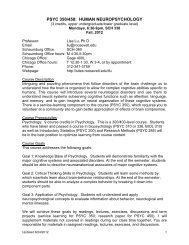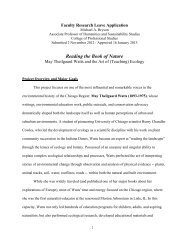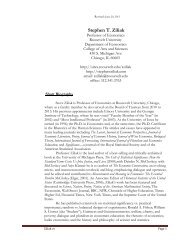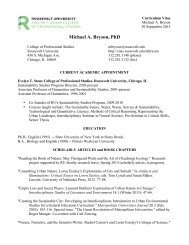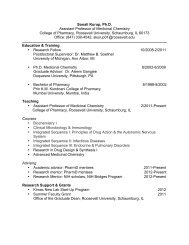Social Insurance and Public Assistance
public-assistance-welfare-reform-colonial-times-to-the-present-ziliak ...
public-assistance-welfare-reform-colonial-times-to-the-present-ziliak ...
You also want an ePaper? Increase the reach of your titles
YUMPU automatically turns print PDFs into web optimized ePapers that Google loves.
824 Series Bf802–813 Bf SOCIAL INSURANCE AND PUBLIC ASSISTANCE<br />
TABLE Bf802–813 Employee-benefit plans – estimated number of workers covered, by type of benefit: 1950–1975<br />
Contributed by Price V. Fishback <strong>and</strong> Melissa A. Thomasson<br />
All wage <strong>and</strong> salary workers<br />
With hospitalization<br />
coverage<br />
Wage <strong>and</strong> salary workers in private industry<br />
With coverage<br />
for temporary<br />
disability including<br />
formal sick leave<br />
Written in<br />
With accidental compliance With With major In compliance With With<br />
With life death <strong>and</strong> with California With regular medical with state coverage for supplemental With<br />
insurance <strong>and</strong> dismemberment temporary surgical medical expenses temporary long-term unemployment retirement<br />
death benefits coverage Total disability law coverage coverage coverage Total disability laws disability coverage coverage<br />
Bf802 Bf803 Bf804 Bf805 Bf806 Bf807 Bf808 Bf809 Bf810 Bf811 Bf812 Bf813<br />
Year Million Million Million Million Million Million Million Million Million Million Million Million<br />
1950 19.4 8.1 24.3 1.2 17.7 8.2 — 20.1 6.6 — — 9.8<br />
1951 20.8 9.5 27.1 1.4 21.7 10.7 — 21.7 6.8 — — 10.8<br />
1952 22.3 10.7 28.8 1.5 24.2 12.7 0.2 22.4 7.0 — — 11.3<br />
1953 24.2 11.8 31.0 1.5 26.9 15.8 0.5 23.4 7.0 — — 12.6<br />
1954 25.7 14.0 31.1 1.4 27.8 17.5 0.8 22.9 6.7 — — 13.4<br />
1955 28.1 15.6 32.8 1.4 30.2 20.2 2.2 23.5 6.8 — 1.0 14.2<br />
1956 29.8 17.3 35.1 1.5 32.4 22.0 3.5 24.7 7.1 — 2.0 15.5<br />
1957 31.2 18.4 36.4 1.6 34.2 23.9 4.9 24.9 7.2 — 1.9 16.7<br />
1958 31.7 18.7 36.2 1.4 34.1 24.5 5.9 23.8 6.8 — 1.7 17.2<br />
1959 33.5 19.7 37.2 1.5 35.4 26.1 7.2 24.4 6.9 — 1.9 18.2<br />
1960 34.2 20.9 39.3 1.2 37.4 28.2 8.8 24.5 6.8 — 1.7 18.7<br />
1961 35.5 21.3 39.9 1.1 38.0 29.8 10.3 24.6 6.8 — 1.9 19.2<br />
1962 36.4 22.6 41.0 0.9 39.0 31.3 11.7 25.3 6.8 — 1.8 19.7<br />
1963 37.8 24.7 42.6 0.3 40.8 33.3 13.2 23.6 6.2 0.7 1.8 20.3<br />
1964 40.1 26.5 43.9 0.3 41.8 35.4 14.7 23.9 6.2 1.2 2.0 20.9<br />
1965 41.9 28.4 45.7 0.3 43.4 38.2 16.6 24.5 6.4 1.9 2.1 21.8<br />
1966 43.5 28.5 47.2 0.4 45.2 40.2 18.3 25.5 6.6 2.3 2.2 22.7<br />
1967 45.7 30.4 48.7 0.4 47.0 42.5 20.2 26.0 6.7 3.7 2.2 24.3<br />
1968 48.2 33.7 50.1 0.4 48.3 43.6 21.7 27.9 6.7 4.6 2.2 24.8<br />
1969 49.0 36.5 52.1 0.4 50.6 46.1 23.4 29.4 6.9 5.5 2.2 26.0<br />
1970 52.0 38.7 53.1 0.4 51.5 48.0 24.6 29.7 7.1 7.0 2.2 26.1<br />
1971 53.5 39.2 53.2 0.4 51.7 48.3 25.7 30.1 6.9 7.9 2.2 26.4<br />
1972 55.6 40.7 54.2 0.4 52.9 49.4 26.4 31.3 7.1 9.5 2.0 27.5<br />
1973 57.8 42.7 56.8 0.4 55.4 53.7 27.6 32.0 7.2 10.6 2.1 29.2<br />
1974 60.6 44.3 57.6 0.4 56.1 54.9 28.2 31.7 7.0 11.1 2.0 29.8<br />
1975 62.4 46.5 58.2 0.4 56.6 56.1 29.6 31.1 7.0 11.5 1.9 30.3<br />
Sources<br />
Martha Remy Yohalem, “Employee-Benefit Plans, 1975,” <strong>Social</strong> Security Bulletin<br />
38 (11) (1977): 20, <strong>and</strong> Alfred M. Skolnik, “Twenty-five Years of Employee-<br />
Benefit Plans,” <strong>Social</strong> Security Bulletin 39 (9) (1976): 5.<br />
Documentation<br />
An “employee-benefit plan,” as defined here, is any type of plan sponsored<br />
or initiated unilaterally or jointly by employers or employees <strong>and</strong> providing<br />
benefits that stem from the employment relationship <strong>and</strong> are not underwritten<br />
orpaid directly by government (federal, state, or local). In general, the<br />
intent is to include plans that provide in an orderly predetermined fashion<br />
(1) income maintenance when regular earnings are cut off because of death,<br />
accident, sickness, retirement, or unemployment, <strong>and</strong> (2) benefits to meet<br />
medical expenses associated with illness or injury. The plans exclude workers’<br />
compensation required by statute <strong>and</strong> employer’s liability.<br />
Government employees who are covered by plans underwritten by nongovernmental<br />
organizations are included in the series, whether or not the<br />
government unit contributes (as an employer) to the financing of the program.<br />
Specifically included here are plans providing government employees<br />
with group life insurance, accidental death <strong>and</strong> dismemberment insurance,<br />
<strong>and</strong> hospital, surgical, regular medical, <strong>and</strong> major-medical expense insurance.<br />
Retirement <strong>and</strong> sick-leave plans for government employees, which are<br />
financed <strong>and</strong> administered directly by government, are excluded from the<br />
series.<br />
Coverage data are generally based on the number of active participants<br />
(those currently employed) <strong>and</strong> may include persons who have been temporarily<br />
laid off or retired. The practice of continuing coverage for a retired<br />
worker is particularly prevalent in group life insurance. Many group life <strong>and</strong><br />
health plans permit a person on layoff to continue coverage in the group for<br />
three to six months, <strong>and</strong>, in some cases, even longer. In addition, workers who<br />
have terminated employment may carry vested pension rights; these persons<br />
are often included in the total coverage group. No attempt has been made to<br />
correct the coverage data for such limitations; therefore, the proportion that<br />
covered employees represent of all employed workers <strong>and</strong> the proportion<br />
that contributions represent of aggregate payrolls are somewhat overstated.<br />
Nevertheless, long-run growth patterns for the various types of plans remain<br />
valid.<br />
Series Bf802. Group <strong>and</strong> wholesale life insurance coverage is based on data<br />
from the Institute of Life <strong>Insurance</strong>, Group Life <strong>Insurance</strong> <strong>and</strong> Group Annuity Coverage<br />
in the United States, annual issues, modified to exclude group plans not<br />
related to employment. It also excludes coverage under servicemen’s group<br />
life insurance plans. Self-insured death-benefit plan coverage is based on<br />
data for various trade-union, mutual benefits association, <strong>and</strong> companyadministered<br />
plans.<br />
Series Bf803. Accidental death <strong>and</strong> dismemberment coverage is from Health<br />
<strong>Insurance</strong> Association of America, Group Health <strong>Insurance</strong> Coverage in the United<br />
States, annual issues.<br />
Series Bf804 <strong>and</strong> Bf806–807. Data on hospitalization, surgical, <strong>and</strong> regular<br />
medical coverage are from Marjorie Smith Mueller <strong>and</strong> Paula A. Piro, “Private<br />
Health <strong>Insurance</strong> in 1974: A Review of Coverage, Enrollment, <strong>and</strong> Financial<br />
Experience,” <strong>Social</strong> Security Bulletin 39 (3) (1976): 3–20.; Health <strong>Insurance</strong><br />
Association of America, Group Health <strong>Insurance</strong> Coverage in the United States,



